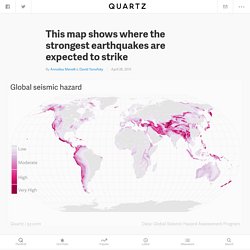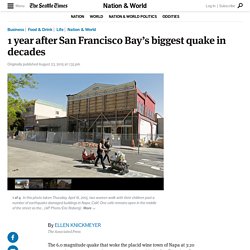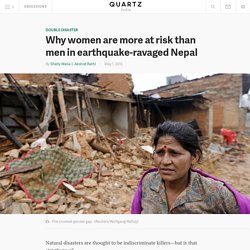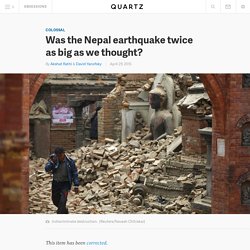

Earthquake Hazards Program. This map shows where the strongest earthquakes are expected to strike. Munmun Mukherjee is a good patient.

She lies quiet on the white stone delivery table of the government hospital in Kolkata, but for an occasional low moan. Even this is muted, the edge of her voice flattened, as if she knows that she needs to be on her best behaviour. A slim, dusky woman, she looks tidy even in her tired, crumpled nightie. It is late January, and the reluctant Kolkata winter has already slipped away. Why Earthquake-Resistant Cell Phone Towers Are Worth the Money - Pacific Standard. Last week, Los Angeles became the first American city to require that new cell phone towers be built to withstand an earthquake.

Previously, cell towers only needed to be able to resist falling (and killing people) during a quake, the Los Angeles Times reports. This new law is a reflection of changing times. The last major California earthquake was in the Northridge neighborhood of Los Angeles, in 1994. Most of the general public didn't have cell phones then, nor did they rely much on the Internet. But around the world, other regions' more recent quakes offer examples of how profoundly California's next tremblor could affect mobile service: What do people tend to use cell phones for after an earthquake? Keeping—or returning—mobile service is also important to restoring a region's economy after a disaster. Advertisement — Continue reading below. The Earthquake That Will Devastate Seattle.
1 year after San Francisco Bay’s biggest quake in decades. The 6.0 magnitude quake that woke the placid wine town of Napa at 3:20 a.m. on Aug. 24, 2014 was the strongest quake to hit the San Francisco Bay area in a quarter-century.

It killed one person and injured 200 as bricks and furniture – and wine bottles – toppled onto sleeping families. One year later, the signs of lingering damage are minimal – a wobbly winery building here, a shrouded, Victorian-era downtown facade awaiting repairs there. The Great Quake and the Great Drowning. In the year 1700, on January 26, at 9:00 at night, in what is now northern California, Earthquake was running up and down the coast.

His feet were heavy and when he ran he shook the ground so much it sank down and the ocean poured in. “The earth would quake and quake again and quake again,” said the Yurok people. “And the water was flowing all over.” The Aftershocks — Matter. 2011 Tōhoku earthquake and tsunami. The 2011 earthquake off the Pacific coast of Tōhoku (東北地方太平洋沖地震, Tōhoku-chihō Taiheiyō Oki Jishin) was a magnitude 9.0–9.1 (Mw) undersea megathrust earthquake off the coast of Japan that occurred at 14:46 JST (05:46 UTC) on Friday 11 March 2011,[5][11][12] with the epicentre approximately 70 kilometres (43 mi) east of the Oshika Peninsula of Tōhoku and the hypocenter at an underwater depth of approximately 29 km (18 mi).[5][13] The earthquake is often referred to in Japan as the Great East Japan Earthquake (東日本大震災, Higashi nihon daishinsai)[14][15][fn 1] and is also known as the 2011 Tōhoku earthquake,[30] the Great Sendai Earthquake,[31] the Great Tōhoku Earthquake,[31] and the 3.11 earthquake.

Earthquake The main earthquake was preceded by a number of large foreshocks, with hundreds of aftershocks reported. Geology Tōhoku earthquake and aftershocks from 11 to 14 March. Connecting the Last Mile: the Role of Communications in the Great East Japan Earthquake by Internews Europe. History, Travel, Arts, Science, People, Places. Japan Earthquake - April 2016. Nepal Earthquake - April 2015. Stark Photos Show Nepal’s Heritage Sites Before and After the Quake.
Historical Monuments after the earthquake at Kathmandu Durbar Square.

Image by Ajaya Manandhar. Copyright Demotix (25/4/2015) The earthquake that shook Nepal on April 25 has claimed more than 7,000 lives and injured twice as many people. Around 8 million people have been affected with at least 2 million displaced. This Interactive Map Shows Nepal Before and After the Earthquake. Why women are more at risk than men in earthquake-ravaged Nepal. Natural disasters are thought to be indiscriminate killers—but is that strictly true?

It turns out disasters affect women much more than men. Was the Nepal earthquake twice as big as we thought? This item has been corrected.

On April 25, Nepal was hit with the biggest earthquake in 80 years—but just how big was it? Amidst the destruction, there was a spat on the issue between the US and China. The US Geological Survey (USGS), which monitors earthquakes worldwide, reported that the Nepal earthquake measured at a magnitude of 7.8. However, the China Earthquakes Network Center (CENC), which hopes to provide a similar service, measured the same earthquake at a magnitude of 8.1. Gone: The Earthquake in Nepal. Gone.

This one word is in heavy use right now. Heavy as in frequent, and heavy as in weighty. An Oral History of Langtang, the Valley Destroyed by the Nepal Earthquake. This scene is based on earthquake footage taken in Langtang Valley by American trekker Corey Ascolani.

Illustration by Owen Freeman On April 25 of this year, a magnitude 7.8 earthquake hit Nepal at 11:56 a.m., local time. Half a million homes across the country were leveled and more than 8,500 people were killed, including 19 climbers and Sherpas who died in an avalanche that roared through Mount Everest Base Camp. How Not to Report on an Earthquake. Photo As of Tuesday morning, exactly three days have passed since a 7.8-magnitude earthquake shook Nepal, killing thousands and leaving millions in need of help.
In disaster response, the end of the first 72 hours is often considered an inflection point: the unofficial moment when the most acute phase passes, the odds of finding trapped survivors plunge and the relief effort tends to really pick up steam. Three days into a crisis, roads and airports are often reopening, and outside responders and journalists are arriving in droves. The decisions made at this time can determine the course of the response. A misstep now can have ramifications lasting years, even decades. I know this because I lived through a moment of just this sort five years ago, in Haiti.
The Psychology of Inevitable Earthquakes. Everyone knew the Big One was imminent. And no one was quite ready. That's the unshakeable impression you get from the archives of the English-language Nepali Times, which make for eerie reading in the wake of Saturday's 7.8-magnitude earthquake. In a matter of seconds, the temblor reduced iconic landmarks to rubble, inflicted billions of dollars in damage, nearly extinguished entire villages, drove hundreds of thousands of people from their homes, and left at least 5,000 dead in Nepal. From remote Nepal, a warning against ahistorical disaster relief. Editor’s note: David Citrin is a medical anthropologist who has lived and worked in remote western Nepal since 2001.
He was there when the earthquake hit and offers advice on how to make this recovery response more lasting and effective. By David Citrin, special to Humanosphere. Ecuador Earthquake - April 2016.